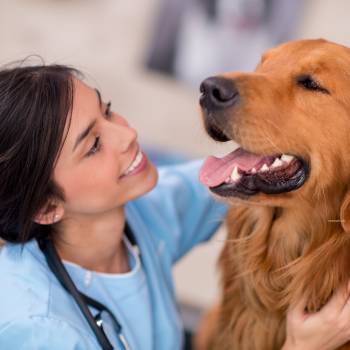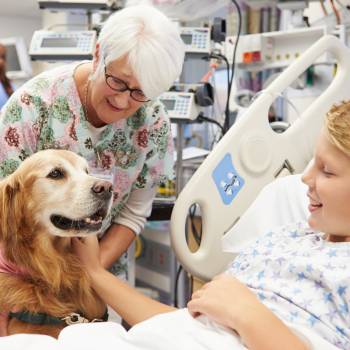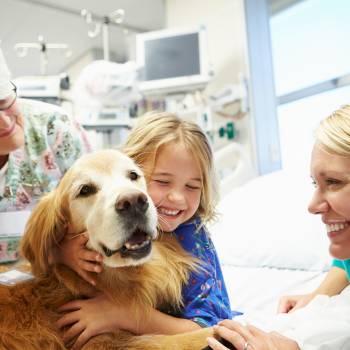
Origins Of The Dog
Hi everyone, thanks for joining me on this edition of Val Talk’s Pets. How many times have you heard someone say, “Well you know, dogs come from wolves”. Do they? […]
 play_arrow
play_arrow“Human” Foods For Pets Val Cairney

 play_arrow
play_arrowShould Pets Be Allowed In Hospitals? Val Cairney

Hi everyone, and thanks for joining me on this Val Talk’s Pets episode. Here is a question for you. Should pets be allowed to visit patients in a hospital? I’ll bet all the pet people are nodding yes! In this episode, I’d like to explore the idea of pets in hospitals for patients, staff, and long-term care facilities. So, let’s get at it!
Let’s start with hospitals.
Animals visiting or being at a hospital can be separated into three categories. There is the question about allowing a pet to visit someone in the hospital; the pet belonging to the patient. Then there are therapy dogs that are allowed to visit and then there are dogs that provide support for staff in high-stress positions.
Because a patient’s pet visit has its pros and cons, I’d like to start with support dogs for personnel. As I am more familiar with National Service Dogs I’ll highlight their programme in this category. NSD facilitates a programme called Canine Assisted Intervention. Quoting from their official website, “NSD” ‘s Canine Assisted Intervention Program is uniquely positioned to provide mental health support services to people of all ages.

CAI Dogs can reduce stress levels among staff, clients and others, while promoting healing, improving overall well-being and inspiring hope for a bright future.” (nsd.on.ca/canine-assisted-intervention) There are education facility dogs, justice facility dogs, and operational stress intervention dogs in the CAI. Although the CAI Dogs are multi-faceted, the OSID dogs are the ones that can and are placed in hospitals and other facilities to aid with staff stress.
Imagine a nurse having an even more stressful day than usual, or a surgeon who has just lost a patient. Going to their staff area to decompress and have a trained dog there to provide comfort could mean all the difference for the mental health of that health care worker. If someone isn’t a dog person, that’s fine. These dogs know how to judge a situation. But, just imagine some of the stress melting away as a non-judgmental dog sits with you and rests its head in your lap.
Dog people often get this at home but at work? Isn’t it amazing that during this time when everything is about technology and artificial intelligence etc., the best thing still is that warm contact with an animal that just knows how to make you feel a bit better?
Harvard Business Review has been looking into this topic of pets in the workplace. The topic of pets in the workplace is one unto itself as today we are talking about hospitals and care facilities, but the research does include hospitals in a staff projection.
The paper entitled, “Research: The Benefits of a Pet-Friendly Workplace, ” states, “Welcoming pets has tangible benefits. Studies in diverse settings–traditional offices and universities, prisons, hospitals, and courthouses – demonstrate that the presence of animals increases employee commitment and career satisfaction and reduces turnover intentions.” (hbr.org/2023/11/research-the-benefits-of-a-pet-friendly-workplace)

There is a lot of progress when it comes to the healing effects of animals, and after the pandemic, many, many things changed. The idea of a health provider thinking of the well-being of its staff through canine intervention particularly shows a progression towards an acknowledgment of the healing benefits of animals.
I know myself, there have been days when I need to pick up our work cat and just hold her and breathe in her energy. It helps.
Let’s now look at therapy dogs brought to hospitals and facilities to interact with clients and patients. Therapy dogs go through a training programme and become certified by the body providing the training. Usually, the dog is in the programme with their owner who believes their dog has what it takes to be a therapy dog and the human wants to volunteer to help in this regard.
St. John’s Ambulance for example provides a course to certify a dog into being a therapy dog. Not every dog is suited, but generally, if the dog is friendly, and very well-trained, meaning it knows its manners well and can show gentleness and empathy to someone in a situation, the dog could be quite suited to this vocation.
Some therapy dogs are regular visitors to a particular hospital or facility and the patients and staff get to know them and anticipate their visit. The Ottawa Hospital gave a lovely explanation of the scientific benefits of therapy dogs. Dr. Christine Boisvert, “a clinical and rehabilitation psychologist at The Ottawa Hospital” explains what a therapy dog can provide within a hospital setting.

Therapy animals can make a difference for those in a hospital or long-term facility. There is a photo that circulates online where a line-up of therapy dogs standing in front of doors at a hospital, waiting to begin their day visiting, all wearing these little backpacks. Any kind of dog really can become a therapy dog as long as it has the proper demeanour. Larger breeds tend to be used, but there is a place for smaller dogs that can be petted on the lap or just fit better in smaller spaces.
I’ve looked at the trained Canine Assisted Intervention programme with National Service Dogs that can support staff in hospitals and therapy dogs that visit hospitals and facilities to provide comfort, so that brings us to what about having your pet come into a hospital or facility to visit? The other two types of dogs I have discussed are trained to be in the facility. A person’s pet may not have the same manners and wherewithal to handle coming into a hospital.
Let’s look at personal pets coming into hospitals or hospital-like environments.
More and more hospitals are getting with “the program” shall we say, of letting a person’s pet come to visit if someone is in a longer stay in hospital. According to vetstreet.com, the University of Maryland Medical Center started the “Faithful Friends personal pet visitation program in 2008. Wolfson Children’s Hospital in Jacksonville Florida has Healing Paws as a program. Rules apparently will vary from hospital to hospital.
As vetstreet.com explains, “Some have a designated area of the hospital where the visit takes place; others allow families to bring the pet right to the patient’s room.” Some hospitals allow dogs and cats, some just dogs. Some visits may be one hour, some the entire day. Faithful Friends for example, “has measures in place to ensure patient and staff safety at all times.” “In addition to bathing and grooming before the visit, each pet must have a health certificate signed by his veterinarian that indicates the animal is up-to-date on immunizations, flea and tick-free and relatively good-natured.”
In Ontario, Canada, Juravinski Hospital in Hamilton allows pets to visit. Their program is called, Zachary Paws for Healing. At Juravinski they came to these conclusions:
Pets also have to be at least 6 months old. For a pet visit at Juravinski for example, a person would contact Zachary’s Paws for Healing to request a visit. They take care of everything from there.
As for long-term facilities, the guidelines are particular to the facility.
I googled which hospitals in Ontario allow pet visits and it gave a list. However, some on the list were veterinarian offices, so you need to weed through. If you have someone in a hospital, it is easy enough to look into that hospital specifically to see if they have a human-pet visit program and what their guidelines are.

The pros of a person’s pet coming to visit are many. A patient seeing their dog or cat can do wonders for morale, dropping blood pressure, and creating a more positive and healing environment. The pet also receives so much for finally seeing their human, avoiding despondency and health issues arising from feeling abandoned and forlorn.
The cons, of course, include how others in the hospital may feel. If the patient is in a room with others, they may be allergic to cats or dogs or afraid of animals. This is why it is really important to consult each hospital’s guidelines to ensure the visit doesn’t create stress for others.
So, what do you think? Should pets be allowed in hospitals if we are in for a longer period of time? My vote, of course, is Absolutely! But I would be very diligent in sticking to the rules. I completely understand why Juravinski has a social worker involved when a pet is coming to visit.
But, oh my, if I were in hospital for an extended time, meaning more than a few days, I would be so grateful if Tundra and Rory could come for a visit. It would be everything to me. And that is what almost all pet parents are thinking. The bottom line is that there is no reason to believe a dog or cat will create any more risk than visitors coming from the bus, from work, to visit. Pet visits can be arranged. It just means some protocols and guidelines have to be put in place. So, should pets be allowed in hospitals? I wholeheartedly believe so, for the well-being of the patient and the pet.
If you find yourself in this situation, just contact the hospital and find out if they have a pet visitation program and the rules. Just imagine being able to take your friend or loved one their treasured dog or cat. What a time that would be. Research is all that is needed because as I say, knowing is caring.

To hear more about National Service Dogs and others, please listen to these Val Talks Pets episodes:
Tagged as: benefits of animals in hospitals, animals in hospitals, cats in hospitals, dogs in hospitals, pets in hospitals, working dogs in hospitals.
Hi everyone, and welcome to Val Talk’s Pets, the forum for pet parents and enthusiasts alike. So, I have been working in the pet industry now for almost 10 years and, on a daily basis, I handle a lot of issues and questions arising from pet parents. I am not a veterinarian but I do have certifications in Canine, Feline, Small Animal, Fish and Herptile and Avian Health and Nutrition from the University of California, Davis Extension, the Vet College.

Val Cairney November 1, 2024
Hi everyone, thanks for joining me on this edition of Val Talk’s Pets. How many times have you heard someone say, “Well you know, dogs come from wolves”. Do they? […]

Val Cairney October 31, 2025

For the price of a coffee, or more if you are feeling generous, you can help keep this podcast going & growing. Please visit my ko-fi page to make a donation. Thanks!
all rights reserved - Val Talks Pets - 2024